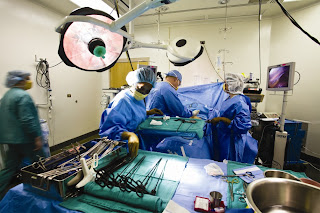Anytime anesthesia is used in childbirth, whether local, regional or general, augmenting the effect by adding music to the picture will be beneficial. Especially in the case of childbirth, where the baby is also experiencing the anesthesia that mother receives, wearing the surgery headphones with calming, soothing music will be a plus!
Anesthetics: Options for Childbirth
Haven't got time for the pain? From total unconsciousness to spinals and blocks, traditional medicine offers a range of pain relief, each with its own benefits and drawbacks.
Anesthetics, substances that cause partial or complete loss of sensation, have long been the most common pain relief for labor and delivery. Here are the most commonly used anesthetics.
General and Regional Anesthesia During Childbirth
Decades ago, women were commonly put under general anesthesia, which quickly puts the entire body (and mind, of course) completely to sleep. It’s the same stuff you’d get — usually inhaled, although sometimes it is delivered intravenously, or through a combination of routes — if you were having open heart surgery or a kidney removed. Though it’s extremely safe, it is as extreme as it sounds, which is why general anesthesia isn’t used today for childbirth unless an emergency cesarean is required and there’s no time to give a regional anesthetic (like a spinal block). General anesthesia can also be required in a difficult vaginal breech birth, to deliver the baby’s head.
What general anesthesia does: If you have to have general anesthesia, expect to be totally knocked out for the entire birth. You’ll wake up groggy, disoriented, perhaps restless, and with a sore throat from the endotracheal tube (used to ensure that you don’t breathe the contents of your stomach into your lungs). You’ll also probably be rather queasy and may vomit, and will have sluggish bowels and bladder. The effects vary from person to person.
Just as you’re sedated temporarily (to get you through the delivery), so too will your baby be (temporarily). To reduce the effect, the anesthesiologist will try to put you out very close to your actual delivery, reducing the amount of drugs that get through your system and into the baby.
Epidural During Childbirth
Your baby won’t be affected by an epidural, the pain relief of choice for half of all laboring women (including both vaginal and cesarean) delivering at hospitals. An epidural is also an anesthetic, but it is injected directly into the spine (technically, into the epidural space, which is located between the ligament that sheathes the vertebrae and the membrane that covers the spinal cord), and so the drug bypasses the bloodstream — making it safer for your baby. In the past, there was some concern that an epidural might increase the likelihood of cesarean section (because it might prolong the labor), but recent studies dispute that notion.
How epidurals are administered: It’s not an instant shot; an anesthesiologist must administer an epidural through a thin catheter that is inserted into your back, and it could take 15 minutes (or longer) for the drugs to kick in. But it could be given to you as soon as you ask for one — no need to wait until you’re dilated a certain amount (like three or four centimeters) as used to be recommended. Studies now show that even an early epidural doesn’t increase the chances of C-section as was once believed.
You’ll first be put on an IV (the effect of the drugs can sometimes dramatically lower blood pressure; the fluids will keep it from going too low). You’ll then have to lie on your left side or sit leaning over a table or your coach, and your back will be swabbed with antiseptic. You’ll feel the prick of a local anesthetic, and then a large needle (which you won’t feel) will be inserted into the epidural space. Through that needle, the anesthesiologist inserts a catheter — the thin tubing that will be left behind (and taped to your back) and through which the drug is delivered. The needle is then removed and you’ll be able to lie down again. You’ll also have a catheter inserted into your urethra (the loss of lower body sensation from the procedure means you also will have no idea when you have to pee).
How epidurals make you feel: Once the epidural starts working, your entire lower body will feel numb, including the nerves of your uterus, so you won’t feel the pain of contractions (you’ll note the tensing of your uterus and some pressure). Some women have trouble pushing on an epidural (because they can’t feel their body or sense the peak of the contractions); others report no trouble. If you do find you’re having trouble pushing, you can ask to have the epidural turned off for the pushing part. Afterward, you might feel cold, experience numbness on one side of your body, and you’ll be a bit rubbery-legged.
Combined Spinal Epidural
Another epidural option is the combined spinal epidural, a type of epidural available only in some hospitals (ask your practitioner if it’s available in your hospital). The anesthesiologist starts the mom off with a shot of anesthetic directly into the spinal fluid to help relieve some pain, but because the anesthetic is only in the spinal fluid, the woman can still feel and use the muscles in her legs (which is why it’s also called a walking epidural). When the woman feels she needs more pain relief, more medication is placed into the epidural space (through a catheter that was inserted at the same time the spinal medication was administered).
Other Anesthetic Options for Childbirth
Other types of anesthetics you might get include a pudendalblock, which is injected into the perineal or vaginal area to reduce pain there (although you’ll still feel the full force of your contractions), a spinal block (for a cesarean delivery), or a low spinal or saddle block (for forceps assisted delivery or vacuum vaginal extraction). These are given as a simple shot into the fluid around the spinal cord. You’ll be numb, as with an epidural, and may feel queasy afterward. With a spinal, you’ll have to stay flat on your back for about eight hours after delivery.
source: http://www.whattoexpect.com/pregnancy/
Subscribe to:
Post Comments (Atom)







No comments:
Post a Comment